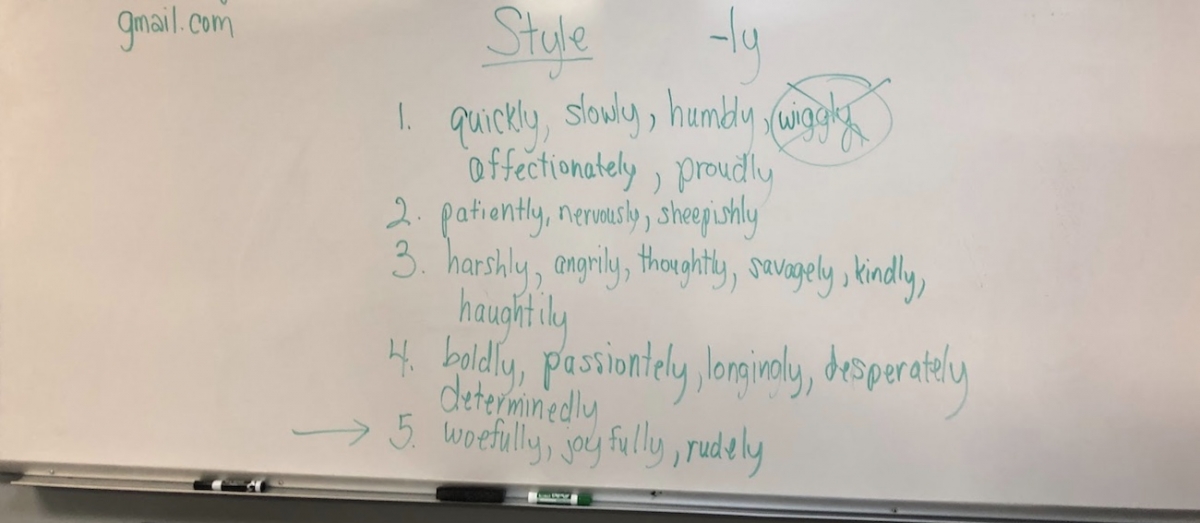
I stood and gazed at the young faces seated before me. They looked back at me. It was the first day of co-op, and I was meeting my class for the very first time. It was very quiet. Too quiet. This may come as a surprise to pupils, but teachers get nervous on the first day of classes too, and I was nervous. Would the kids enjoy my class? Would they engage? Would they, ahem, learn? I had ideas in my brain, and I wanted to communicate those ideas so that they could put them into their brains and use them to expand their communication skills.
We read through the first source and worked together to come up with an outline and test it, but they were still a little reticent. It was time to teach some style. “Open your books to page 23, and we’ll discuss how to add in an -ly adverb,” I instructed.
The -ly adverb is the first dress-up taught in Structure and Style®. I wrote on the whiteboard, “The king walked ____________ to his throne room.” The students stared silently back at me.
“Okay,” I said. “How could a king walk into his throne room?”
One lone hand hesitantly rose near the back of the room. “Slowly?” the student asked.
“Certainly!” I responded. And I began to walk slowly around the room, with my chin held high in a kingly manner. A few cautious smiles started. Another hand rose.
“Quickly?” said the student.
“Sure!” I agreed, now taking quick strides across the room as if I were impatient to get somewhere. The students began to smile more easily.
“How about humbly?” another student asked. Ooh, they were thinking a little more creatively. I liked this! I clasped my hands in front of me and turned my gaze downward as I walked carefully around the classroom. I heard laughter.
I had them! Students began to toss out word after word, some -ly adverbs sillier than the others, all of them shared in the hopes that I would model the action. And then I heard the word, “Wiggly!”
I wrote it on the board and began to model a wiggly walk because I knew that’s really what the students wanted to see. Arms and legs waving oddly, I attempted my best wiggly walk that I could. General hilarity ensued. And then I paused.
“Hmm. Wiggly is a great word, but I wonder if it really works as an adverb. I think we’d better test it out.” I held my pen in front of me horizontally by its very tip and began to gently bounce it up and down. “Does this pen appear to wiggle as I do this?” I asked the class. The kids thought the illusion of a pen appearing to bend as it bounced was pretty neat. They all agreed that it did indeed appear to wiggle.
“So if the pen appears to wiggle, would you say that it’s a wiggly pen?” I asked. Yes, the class agreed. It was definitely a wiggly pen.
“What part of speech is the word pen?” I continued.
A student in the first row responded, “A noun!”
“Yep,” I said. “A pen is a thing, which makes it a noun. Does anyone know what types of words describe nouns?” I asked.
“Adjectives?” responded the same student.
“Yes, so really the word wiggly is an adjective. It’s a great adjective, by the way, but it’s not really an adverb. You can call it an imposter -ly word. Let’s cross it off our list.” And I circled the word and put a slash through it.

The class was nearly over. I had managed to connect with my students and draw out a few smiles as well as a giggle or two. The kids appeared to be pretty comfortable with -ly adverbs and had even learned that not all -ly words are adverbs; some are imposters that are actually adjectives.
Andrew Pudewa is a true master teacher. He knows that humor is a powerful tool for learning. His presentation, “Humor in Teaching and Speaking” is one I have listened to several times. The first time I heard it convinced me that my students would learn better if they enjoyed the time they spent in my class, and that humor is an especially engaging way to connect, not only with students, but with people in general. I know, for instance, that I personally remain much more engaged in a presentation if I believe the speaker is funny. And I am better able to remember what I hear when I’m able to connect it with something that made me laugh. I think it’s part of the human experience: people all enjoy a good laugh.
If you are teaching students this year, whether they are your own children or a class full of other students, and whether you are naturally funny or not, see if you can insert a little bit of mirth into your lessons. I think you’ll find that laughter is the secret sauce that stimulates learning and connection. Incidentally, my joke for class was, “Why were the Middle Ages also called the Dark Ages?” Answer? “It was a time of knights!”
IEW® and Structure and Style® are registered trademarks of the Institute for Excellence in Writing, L.L.C.
|
Jennifer Mauser has always loved reading and writing and received a B.A. in English from the University of Kansas in 1991. Once she and her husband had children, they decided to homeschool, and she put all her training to use in the home. In addition to homeschooling her children, Jennifer teaches IEW classes out of her home, coaches budding writers via email, and tutors students who struggle with dyslexia. |

